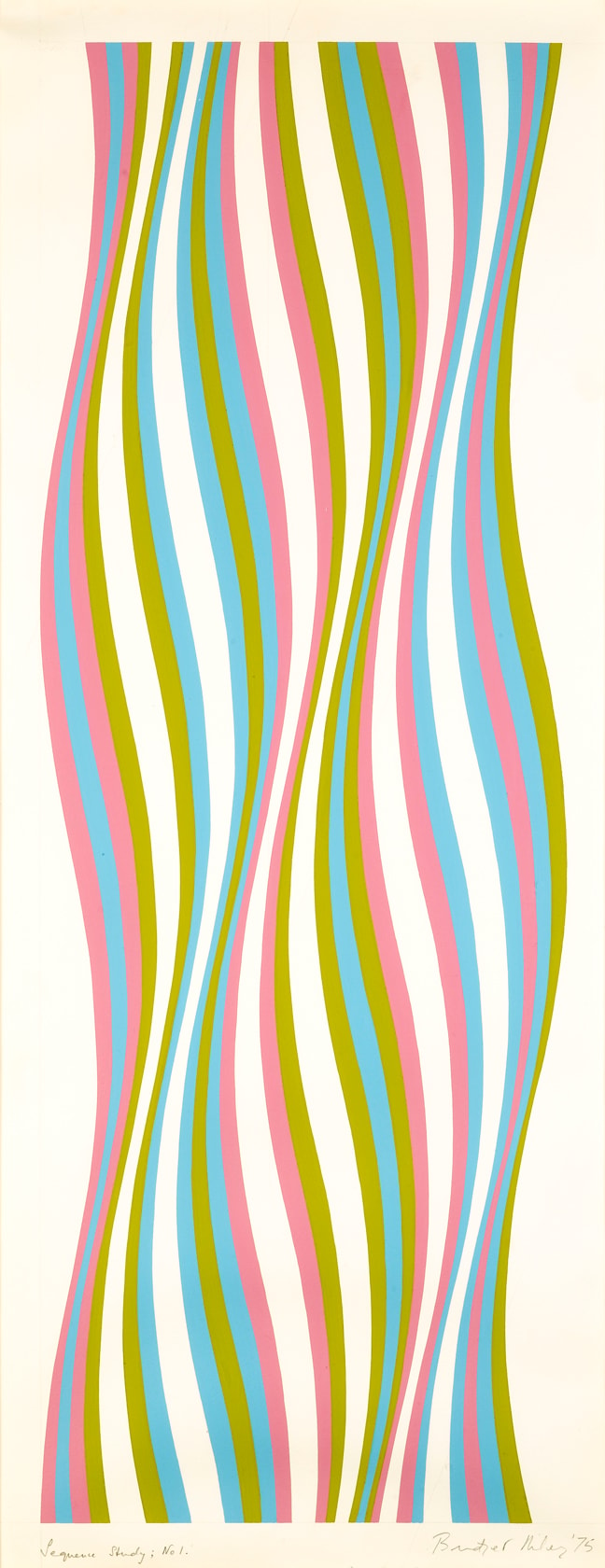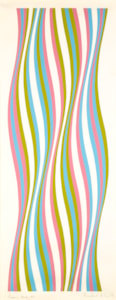Bridget RILEY
( Born 1931)
Sequence Study: No.1
Sold
Gouache and pencil on paper.
Titled, signed and dated Sequence Study; No. 1. and Bridget Riley ’75 at the lower left and right.
890 x 353 mm. (35 x 13 7/8 in.) [sheet]
Titled, signed and dated Sequence Study; No. 1. and Bridget Riley ’75 at the lower left and right.
890 x 353 mm. (35 x 13 7/8 in.) [sheet]
Drawn in 1975, the present sheet may be closely related to a series of so-called ‘Curve Paintings’ executed by Riley between 1974 and 1978. As Paul Moorhouse has noted, ‘Riley’s work from the mid-1970’s until the end of the decade took her concern with colour interaction and its relationship with light to new levels of complexity. The vehicle for these developments was her adoption, in 1974, of the curve form as the fundamental unit of her paintings…Underlying her reintroduction of the curve was the realisation that the length of the edge is crucial in facilitating the interaction of colour: a meandering wave form extends that edge. Also, subjecting a field of curves to diagonal stresses so that they are pulled out of regular alignment, and simultaneously varying their width, means that the juxtaposition of different colours is vastly increased.’
As Paul Moorhouse has written of the ‘curve’ paintings of the second half of the 1970’s, ‘A broadening and deepening of Riley’s understanding of the relation of colour and light can be discerned in her curve paintings. The key to this is the role of the curve in creating a more pliable, less assertive structural armature – one that readily recedes behind the light displays – so that occasionally the effect is as delicate as stained glass. This is also a structure in subtle movement. The eye follows the course of a curve and loses the thread as the shapes begin to fuse, dissolving like a rising haze of heat or undulating like ripples on the surface of water. These effects are non-descriptive yet tantalisingly evocative, recalling the patterns and rhythms of nature. They are also deeply expressive…The curve paintings include some of the most serene and emotionally radiant that she has ever painted.’
In an unpublished 1978 interview, Riley recalled that, ‘In the mid-Seventies I started to use the curve again, this time as a rhythmic vehicle for colour…By using twisted curves I could bunch up colour sensations in a way that went further than the lateral groupings…When colours are twisted along the rise and fall of a curve their juxtapositions change continually. There are innumerable sequences each of which throws up a different sensation. From these I build up clusters which then flow one into another almost imperceptibly.’ More than thirty years later, she again addressed this important series of Curve Paintings’ of late 1970’s: ‘The curves came and with them a rise and fall in space. They were very delicately balanced; each of the five colour groups had to be adjusted and readjusted. Only when a group had been examined, in many different juxtapositions, and all preliminary studies had been completed, could I see the thing as a whole…I worked on them and their studies until I got them to a point of such refinement that they became too delicate, not robust enough.’
Riley also developed the composition of this drawing in an important series of three large colour screenprints - entitled Green Dominance, Blue Dominance and Red Dominance - published in 1977.
As Paul Moorhouse has written of the ‘curve’ paintings of the second half of the 1970’s, ‘A broadening and deepening of Riley’s understanding of the relation of colour and light can be discerned in her curve paintings. The key to this is the role of the curve in creating a more pliable, less assertive structural armature – one that readily recedes behind the light displays – so that occasionally the effect is as delicate as stained glass. This is also a structure in subtle movement. The eye follows the course of a curve and loses the thread as the shapes begin to fuse, dissolving like a rising haze of heat or undulating like ripples on the surface of water. These effects are non-descriptive yet tantalisingly evocative, recalling the patterns and rhythms of nature. They are also deeply expressive…The curve paintings include some of the most serene and emotionally radiant that she has ever painted.’
In an unpublished 1978 interview, Riley recalled that, ‘In the mid-Seventies I started to use the curve again, this time as a rhythmic vehicle for colour…By using twisted curves I could bunch up colour sensations in a way that went further than the lateral groupings…When colours are twisted along the rise and fall of a curve their juxtapositions change continually. There are innumerable sequences each of which throws up a different sensation. From these I build up clusters which then flow one into another almost imperceptibly.’ More than thirty years later, she again addressed this important series of Curve Paintings’ of late 1970’s: ‘The curves came and with them a rise and fall in space. They were very delicately balanced; each of the five colour groups had to be adjusted and readjusted. Only when a group had been examined, in many different juxtapositions, and all preliminary studies had been completed, could I see the thing as a whole…I worked on them and their studies until I got them to a point of such refinement that they became too delicate, not robust enough.’
Riley also developed the composition of this drawing in an important series of three large colour screenprints - entitled Green Dominance, Blue Dominance and Red Dominance - published in 1977.
After studying at the Cheltenham Ladies’ College, Bridget Riley enrolled at Goldsmith’s College of Art in London in 1949. In 1952 she entered the Royal College of Art, studying alongside Frank Auerbach, Peter Blake and Joe Tilson. Her independent work can be dated from 1961, with a series of paintings - in tones of black, white and grey - which were shown the following year in her first solo exhibition, at the Gallery One in London. In 1965 her work came to wider recognition when it was included in the exhibition The Responsive Eye at the Museum of Modern Art in New York, while at the same time an exhibition of sixteen paintings at the Richard Feigen Gallery in New York was sold out before it opened. A second exhibition at Feigen the following year included a large number of drawings and working studies by the artist. In 1966 Riley joined the Robert Fraser Gallery in London, and began moving away from monochrome compositions towards an interest in pure colour. Two years later she was chosen, alongside the sculptor Phillip King, to represent Britain at the 34th Venice Biennale, where she won the International Prize for Painting. In 1970 a large retrospective exhibition of her work, organized by the Arts Council, travelled to cities in Germany, Switzerland and Italy before being shown at the Hayward Gallery in London, where it was seen by more than 40,000 visitors.
Riley has always used assistants to paint her finished paintings, based on her preparatory drawings and gouaches; a practice begun as early as 1961, before her first solo exhibition. Riley’s drawings have often been exhibited alongside her finished paintings, and for her they have been vital. As she has noted, ‘Because my work is based on enquiry, studies are my chief method of exploration and my way into paintings. That is to say, when I start I don’t have an aim or an image in mind for how the painting is going to look. I explore the potential of an element, and the gradually several elements. As I moved on, I introduced colours, different forms of structure and so on. When I started to do studies at the beginning of the 1960s, few other artists made preparatory works…But I felt that – I didn’t just feel, I knew from all the evidence of what was to be seen in museums – that drawing and preparatory work had always played a large part in an artist’s practice. So, I persevered in various ways with whatever elements I was then studying.’
Provenance
Rowan Gallery, London
Marlborough Gallery, London
Private collection, Cleveland, Ohio
Anonymous sale, London, Sotheby’s, 22 June 2007, lot 228
Douglas Cramer, Roxbury, Connecticut, until 2013.




